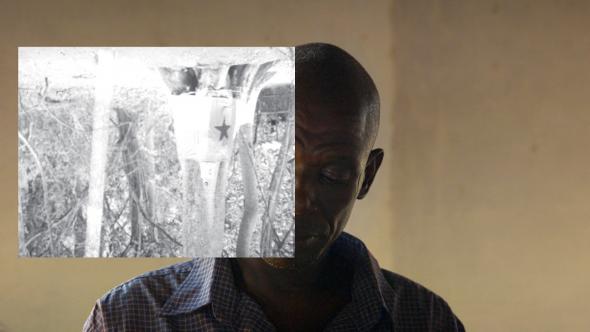Luta ca caba inda: from archive to fragment
 Spell Reel | 2017 | Filipa César
Spell Reel | 2017 | Filipa César
At first it was a gesture. At the height of the liberation struggle, the PAIGC (the African Party for the Independence of Guinea and Cape Verde) decided to send a group of young people to Cuba for professional training. Of the 25 young people who arrived in 1967, four of them - Flora Gomes, Sana na N’Hada, Josefina Lopes Crato and José Bolama Cobumba - were going to study cinema, the idea being that they would subsequently film the struggle. In fact, the struggle was already receiving the militant attention and had appeared in the ound of several documentaries, of which the most famous at the time was Labanta Negro! (Piero Nelli, 1966). The importance of images to the building of the future nation had not escaped Amílcar Cabral1. Indeed, it was characteristic that the ceremony of the declaration of independence on 24 September 1973 (months after Cabral’s assassination) followed a screening of Flora Gomes’ documentary of the PAIGC II Congress, which took place from 18 and 22 July in the liberated regions of eastern Guinea.
Some of the material filmed in the 1970s and 1980s has been deposited with the National Cinema and Audiovisual Institute (INCA), created in 1977 in Bissau. An ‘alliance’ that has brought together Guinean and European artists, filmmakers and researchers has saved the country’s cinematic memory through a recent process of digitization and remastering in Berlin. This alliance has the artist and filmmaker Filipa César (b. 1975) at its epicentre. Some of these films have been shown around the world. They have toured the parts of Guinea in which they were made. They have also underpinned Filipa César’s experimental, self-reflective filmography, most recently in Spell Reel (2017).
This collaborative work of locating, digitizing, disseminating and recomposing was named Luta ca caba inda (The struggle has not yet ended), appropriating the title of an unfinished project that began at INCA in 1980. That project aimed to record the country six years after independence. The same expression has been used as the title of a book - Luta ca caba inda: time place matter voice. 1967- 2017 (Archive Books, 2017) – on the same subject. In it, dialogues and discussions between different protagonists (between 2010 and 2017) intersect with visual documents about the struggle and the subsequent process of nation building. Many of them are unfinished or have never been publicly shown.
The book condenses some important aspects of the project. Its authors are not made explicit, pointing to the collaborative nature of this effort of rescue and rereading. But it also ends up suggesting that this living process of documenting complicates the very notion of authorship as a sovereign gesture with the authority to determine how images are exposed (or concealed), or to guide interpretation and impose meaning. This idea is made clear on the cover with a quotation from Sana na N’Hada:
“At a given moment one seems to be in direct competition with those mischievous things that your images have become in a different context! […] the fact that since the beginning one hasn’t had any agency can itself become quite commendable: the author of the image becomes its owner despite themselves. The image gives itself a new life, a new destiny, with or without us. It overcomes our guardianship”. On the other hand, it is a book composed of fragments: testimonial excerpts, stills, unfinished film records, reports and book covers about the struggle. This idea of fragments takes us back to the precariousness of the archives which, subject historical vicissitudes and to the corrosiveness of time, resemble an “assemblage of shrapnel” (Filipa César, p. 166). In material terms, the recovered (and unrecovered) records are therefore residues of the present, but they also condense images of an unfulfilled past.
In other words, they institute a peculiar regime of historicity in which past, present and future collapse due to the incomplete and unstable nature of the archive. Composed of images and sounds, as well as deletions and silences, the visual documents produce a plot that contemplates representation, historical periods and biographical paths and reframes them in retrospect.
As Paulo Cunha has already emphasized, Filipa César’s work shows how the cinema in Guinea-Bissau synthesizes archaeological vestiges, written documents and subjective memory. This book thus represents the written record of a process of rescue and re-reading. The time it engages with comes alive to the exact extent that its ruined dimension requires carefully recovering existing fragments and at the same time undertaking an hermeneutic exercise that makes them visible and contemporary. _________________
MEMOIRS is funded by the European Research Council (ERC) under the European Union’s Horizon 2020 research and innovation programme (no. 648624) and is hosted at the Centre for Social Studies (CES), University of Coimbra.
- 1. For an overview on cinema in Guinea-Bissau and its role in nation-building, see, among others: Paulo Cunha e Catarina Laranjeiro (2017), “Guiné-Bissau: do cinema de Estado ao cinema fora do Estado”, Rebeca - Revista Brasileira de Estudos de Cinema e Audiovisual 5, 2: 1-23.